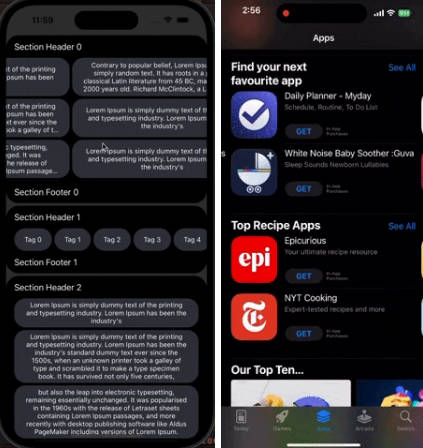CompositionalLayoutViewController
UICollectionViewCompositionalLayout interface to implement complex collection view layout.
Example
To run the example project, clone the repo, and run pod install from the Example directory first.
Requirements
iOS 13.0+
Installation
CompositionalLayoutViewController is available through CocoaPods. To install
it, simply add the following line to your Podfile:
pod 'CompositionalLayoutViewController'
Usage
There are four steps to declare collection view.
Firstly, to compose complex collection view sections, you implement Section class that inherits HashableObject and CollectionViewSection.
class TextFormSection: HashableObject, CollectionViewSection {
...
}
Secondly, implement your sections layout.
func layoutSection(environment: NSCollectionLayoutEnvironment) -> NSCollectionLayoutSection
Thirdly, register cells and supplementary views for collection view in func registerCell(collectionView: UICollectionView) and func registerSupplementaryView(collectionView: UICollectionView).
func registerCell(collectionView: UICollectionView) {
// register cells here
}
func registerSupplementaryView(collectionView: UICollectionView) {
// register supplementary views here
}
Make sure that you implement func supplementaryView(_ collectionView: UICollectionView, kind: String, indexPath: IndexPath) -> UICollectionReusableView?.
You may have to deque UICollectionReusableView from a collection view.
These cells and supplementary views are configured following methods.
func configuredCell(_ collectionView: UICollectionView, indexPath: IndexPath) -> UICollectionViewCell
func configureSupplementaryView(_ view: UICollectionReusableView, indexPath: IndexPath)
You also have to declare var snapshotItems: [AnyHashable] in your section class.
This variable contains datas for each cells.
var snapshotItems: [AnyHashable] {
// return AnyHashable items
}
Finally, you can declare collection view sections in subclass of CompositionalLayoutViewController as follows:
sections = [
TextFormSection(
items: [
.init(
initialText: nil,
textForm: .init(
placeholder: "Email",
validationHandler: { text in
guard let text = text else {
return false
}
return text.isValidEmailAddress()
},
validationAppearance: .init(
textColor: .red
)
)
),
.init(
initialText: nil,
textForm: .init(
placeholder: "Password",
isSecureTextEntry: true
)
)
]
),
ButtonSection(
buttonTitle: "Login",
action: .handler({
print("Login button pressed")
})
)
]
reloadSections()
And also don't forget to assign SectionProvider that manages an array of sections.
public protocol SectionProvider: AnyObject {
var sections: [CollectionViewSection] { get }
func section(for sectionIndex: Int) -> CollectionViewSection
}
override func viewDidLoad() {
super.viewDidLoad()
...
provider = // assign your provider e.g. presenter in VIPER
...
}
To handle cell selection, override func didSelectItem(at indexPath: IndexPath) method in subclass of CompositionalLayoutViewController.
See example code to lean advanced usage.
Author
Akira, [email protected]
GitHub
https://github.com/oneinc-jp/CompositionalLayoutViewController





